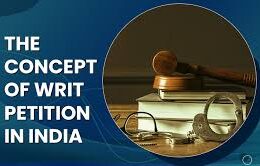
A writ petition is a formal written request or application to a court, seeking a specific remedy or relief. This legal document is typically filed by an individual or entity when they believe that their rights have been violated, or there is an issue that requires the court’s intervention. Writ petitions are commonly used in various legal systems around the world to address constitutional, administrative, or fundamental rights issues. In the words of Dicey, prerogative writs are ‘the bulwark of English Liberty’. The expression ‘prerogative writ’ is one of English common law which refers to the extraordinary writs granted by the sovereign, as fountain of justice on the ground of inadequacy of ordinary legal remedies.
Under the Constitution by virtue of :-
*Article 32, a writ petition can be filed in the Supreme Court. The Supreme Court can issue a writ only if the petitioner can prove that his Fundamental Right has been infringed. It is important to note that the right to approach the Supreme Court in case of a violation of a Fundamental Right is in itself a Fundamental Right since it is contained in Part III of the Constitution.
*Article 226, every High Court has the power to issue directions or orders or writs. This power is exercisable by each High Court throughout the territory in relation to which it exercises jurisdiction. Where an effective remedy is available, the High Court should not readily entertain a petition under Article 226 of the constitution of India e.g., under the Companies Act, a share holder has very effective remedies for prevention of oppression and mismanagement. Consequently High Court should not entertain a petition under the said Article (Ramdas Motors Transport Company Limited T.A. Reddy, AIR 1997 SC 2189).
The Constitution has provided for concurrent writ jurisdiction of the High Courts it is not necessary, that an aggrieved petitioner should first apply to the High Court and then to the Supreme Court (Romesh Thappar v. State of Madras AIR 1950 SC 124) The jurisdiction of the High Court also extends to the enforcement of rights other than Fundamental Rights provided there is a public duty. The Supreme Court’s jurisdiction to issue writs extends to all Fundamental Rights (Common Cause v. Union of India, A.I.R. 1999 SC 2979).
Format of Writ by Supreme Court of India
Types of Writs:
1. Habeas Corpus:
Habeas Corpus is a Latin term that translates to “you shall have the body.” It is a legal principle and writ that protects an individual’s right to personal liberty. The purpose of a habeas corpus petition is to prevent arbitrary detention or imprisonment by ensuring that a person under arrest is brought before a court or judge. The court then examines the legality of the detention and decides whether the individual’s imprisonment is lawful. This is a remedy available to a person who is confined without legal justification. This is in national order to let the Court know on what grounds he has been confined and to set him free if there is no justification for his detention. Under Articles 32 and 226 any person can move for this writ to the Supreme Court and High Court respectively. The applicant may be the prisoner or any person acting on his behalf to safeguard his liberty for the issuance of the writ of Habeas Corpus as no man can be punished or deprived of his personal liberty except for violation of law and in the ordinary legal manner.
Key Elements:
- Swift Judicial Review: Habeas corpus writ is designed to provide a swift and immediate judicial review to prevent unlawful or unjust imprisonment.
- Protection Against Arbitrary Detention: It serves as a crucial safeguard against arbitrary government action, protecting individuals from being held without proper legal justification.
- Right to be Informed of Charges: The writ ensures that individuals are informed of the charges against them and have an opportunity to challenge the legality of their detention.
2. Mandamus:
A Legal Remedy for Administrative Accountability. Mandamus is a Latin term that means “we command.” The writ of mandamus is, a command issued to direct any person, corporation, inferior court, or Government requiring him or it do a particular thing specified therein which pertains to his or its office and is further in the nature of a public duty. . This writ is used when the inferior tribunal has declined to exercise jurisdiction while resort to certiorari and prohibition arises when the tribunal has wrongly exercised jurisdiction or exceeded its jurisdiction and are available only against judicial and quasi-judicial bodies.
Mandamus can be issued against any public authority. It commands activity. The writ is used for securing judicial enforcement of public duties. In a fit case, Court can direct executives to carry out Directive Principles of the Constitution through this writ [State of Maharashtra v. MP Vashi, 1995 (4) SCALE]. The applicant must have a legal right to the performance of a legal duty by the person against whom the writ is prayed for. It is not issued if the authority has a discretion. The Constitution of India by Articles 226 and 32 enables mandamus to be issued by the High Courts and the Supreme Court to all authorities. Mandamus does not lie against the President or the Governor of a State for the exercise of their duties and power (Article 361). It does not lie also against a private individual or body except where the state is in collusion with such private party in the matter of contravention of any provision of the Constitution of a statute. It is a discretionary remedy and the High Court may refuse if alternative remedy exists except in case of infringement of fundamental rights.
Key Elements:
- Purpose: The primary purpose of mandamus is to ensure that public officials and entities carry out their legal duties and functions. It is a remedy to compel action when there is a clear legal right and a corresponding duty that is not being fulfilled.
- Legal Duty: Mandamus is not available for discretionary acts but is generally issued when there is a clear legal duty that is being neglected or ignored.
- No Alternative Remedy: It is often granted when there is no other adequate legal remedy available, making mandamus a last resort to ensure administrative accountability.
Instances Where Mandamus May Apply:
- Government Officials: Mandamus can be sought to compel government officials to perform their statutory duties. For example, if a public officer refuses to sign a document required by law.
- Administrative Bodies: Mandamus may be used to compel administrative bodies to make decisions or take actions required by law within a specified timeframe.
- Judicial Context: In some cases, mandamus can be sought to compel a lower court to act or to compel a judge to exercise their judicial functions.
Limitations:
- Discretionary Acts: Mandamus is not available for discretionary acts; it is only applicable when there is a clear legal duty.
- Availability of Alternative Remedies: Courts may be reluctant to grant mandamus if there are alternative legal remedies available to the petitioner.
3. Prohibition:
A Legal Barrier Against Jurisdictional Excess. Prohibition is a legal writ issued by a higher court to prevent a lower court, tribunal, or quasi-judicial body from exceeding its jurisdiction or acting beyond the scope of its legal authority. This writ serves as a mechanism to ensure that judicial or quasi-judicial bodies stay within the confines of their prescribed powers and do not overstep the legal boundaries. While mandamus commands activity, prohibition commands inactivity, it is available only against judicial or quasi judicial authorities and is not available against a public officer who is not vested with judicial functions. If abuse of power is apparent this writ may be of right and not a matter of discretion.
Key Elements:
- Jurisdictional Limits: Prohibition is invoked when there is a belief that a lower court or tribunal is acting beyond its legitimate jurisdiction.
- Preventive Nature: Unlike other writs, prohibition is largely preventive in nature. It aims to stop an unauthorized or unlawful proceeding before it reaches a conclusion.
- Hierarchy of Courts: Prohibition is typically issued by a higher court, commanding a lower court or tribunal to cease its actions.
Instances Where Prohibition May Apply:
- Exceeding Jurisdiction: When a lower court is perceived to be acting beyond the powers conferred upon it by law.
- Violating Legal Procedures: If there is a violation of legal procedures or principles, and the lower court is deviating from established norms.
- Acting Ultra Vires: When a tribunal or court is acting “ultra vires,” meaning beyond the powers conferred upon it by law.
Limitations:
- Alternative Remedies: Courts may consider whether alternative remedies, such as appeals, are available before granting a writ of prohibition.
- Timing: Prohibition is generally sought at an early stage of the proceedings to prevent further actions from taking place.
4. Certiorari:
Unveiling Judicial Review of Lower Court Decisions. Certiorari is a Latin term that means “to be informed” or “to be made certain.” In the legal context, it refers to a writ issued by a higher court to review and potentially overturn the decision of a lower court, tribunal, or administrative body. Certiorari is often employed as a tool for judicial review, ensuring that legal proceedings are conducted within the framework of the law. It is available to any person, wherever any body of persons having legal authority to determine questions affecting the rights of subjects and having the duty to act judicially in excess of their legal authority. [The King v. Electricity Commissioners, (1924) I.K.B. 171, P. 204-5]. The writ removes the proceedings from such body to the High Court, to quash a decision that goes beyond its jurisdiction. Under the Constitution of India, all High Courts can issue the writ of certiorari throughout their territorial jurisdiction when the subordinate judicial authority acts (i) without or in excess of jurisdiction or in (ii) contravention of the rules of natural justice or (iii) commits an error apparent on the face of the record. The jurisdiction of the Supreme Court to issue such writs arises under Article 32. Although the object of both the writs of prohibition and of certiorari is the same, prohibition is available at an earlier stage whereas certiorari is available at a later stage but in similar grounds, i.e., Certiorari is issued after authority has exercised its powers.
Key Elements:
- Judicial Review: Certiorari is a mechanism through which a higher court can review the decisions of lower courts, tribunals, or administrative bodies to ensure they have acted within their legal authority.
- Error of Law: The writ is typically granted when there is an alleged error of law in the lower court’s decision.
- Quashing Decisions: The primary purpose of certiorari is to quash the decision under review if it is found to be legally flawed.
Instances Where Certiorari May Apply:
- Excess of Jurisdiction: When a lower court or administrative body exceeds its jurisdiction or acts beyond its legal authority.
- Error of Law: If there is an error of law apparent on the face of the lower court’s decision.
- Procedural Irregularities: Certiorari may be sought when there are procedural irregularities in the lower court’s proceedings.
Limitations:
- Discretion of Higher Court: The decision to grant certiorari is often discretionary and depends on the circumstances of each case.
- Availability of Appeals: In some jurisdictions, certiorari may not be granted if there are alternative appellate remedies available to the petitioner.
5. Quo Warranto:
Challenging the Right to Hold Public Office. Quo Warranto is a Latin term that means “by what authority” or “by what warrant.” In the legal context, it refers to a writ used to challenge a person’s right to hold a public office or position. Quo Warranto seeks to determine whether the individual in question has the legal authority, qualifications, and legitimacy to occupy the particular public office.
The writ of quo warranto enables enquiry into the legality of the claim which a person asserts, to an office or franchise and to oust him from such position if he is a usurper. The holder of the office has to show to the court under what authority he holds the office. It is issued when: (i) the office is of public and of a substantive nature, (ii) created by statute or by the Constitution itself, and (iii) the respondent has asserted his claim to the office. It can be issued even though he has not assumed the charge of the office. The fundamental basis of the proceeding of Quo warranto is that the public has an interest to see that an unlawful claimant does not usurp a public office. It is a discretionary remedy which the court may grant or refuse.
Key Elements:
- Authority to Hold Office: Quo Warranto focuses on questioning the authority or right of an individual to hold a specific public office or position.
- Legal Standing: The writ is typically available to individuals who have a legitimate interest in challenging the occupant of the public office.
- Public Office or Franchise: Quo Warranto is not limited to public offices; it can also be used to challenge the right to hold a corporate franchise or certain privileges.
Instances Where Quo Warranto May Apply:
- Illegal Occupation: When there is a belief that an individual is illegally occupying a public office or position.
- Lack of Qualifications: If the occupant lacks the necessary qualifications or has acquired disqualifications for the public office.
- Expiry of Term or Authority: Quo Warranto may be used if the individual’s term has expired or if their authority to hold the office has ceased.
Limitations:
- Statutory Limitations: Quo Warranto is subject to statutory limitations, including specific timeframes within which it must be filed.
- Availability of Other Remedies: In some cases, alternative legal remedies, such as election petitions or impeachment, may be more appropriate.
Conclusion:
In the intricate tapestry of legal mechanisms, writ petitions stand as formidable tools in the pursuit of justice and the safeguarding of individual liberties. From the compelling reach of habeas corpus to the corrective gaze of certiorari, these writs collectively form a crucial aspect of legal discourse, ensuring the proper application of law and the protection of fundamental rights.
Writ petitions, such as habeas corpus, mandamus, prohibition, certiorari, and quo warranto, embody the spirit of legal accountability. They serve as a shield against arbitrary detention, administrative excesses, judicial errors, and unauthorized occupancy of public offices. These legal instruments not only empower individuals to seek redress for infringements on their rights but also act as a check on governmental and administrative overreach.
The evolution of these writs reflects a dynamic legal landscape, where the principles of justice, fairness, and equity continuously shape and refine the contours of legal remedies. Landmark cases have etched indelible marks, setting precedents that resonate across jurisdictions and inspire legal practitioners to navigate the intricate balance between individual freedoms and societal interests.



